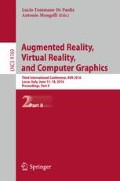Abstract
In this paper we investigate suitable 3D manipulation techniques for a new generation of depth trackers exploitable in ego-vision for an immersive virtual environment. After presenting the specific configuration and hardware used, the paper focuses on an investigation into the advantages and disadvantages of the various techniques in order to choose the one most suitable for the manipulation of an object in an immersive virtual environment. We have faced the problem of canonical manipulation which includes, besides the selection, the positioning and rotation. Two different approaches are described allowing respectively a direct or constrained manipulation of the virtual object. Our aim is to evaluate the perceived usability of the two proposed manipulation techniques in the specific configuration and for this reason qualitative data have been gathered using the System Usability Scale questionnaire. The results show a different level of difficulty perceived by the testers between the two canonical manipulation techniques and a general preference for techniques that prove to be less tiring.
Access this chapter
Tax calculation will be finalised at checkout
Purchases are for personal use only
References
Google cardboard. https://www.google.com/get/cardboard/
Leap motion controller. https://www.leapmotion.com/
Boring, S., Jurmu, M., Butz, A.: Scroll, tilt or move it: using mobile phones to continuously control pointers on large public displays. In: Proceedings of the 21st Annual Conference of the Australian Computer-Human Interaction Special Interest Group: Design: Open 24/7, OZCHI 2009, pp. 161–168. ACM, New York (2009)
Bowman, D.A., Hodges, L.F.: An evaluation of techniques for grabbing and manipulating remote objects in immersive virtual environments. In: Proceedings of the 1997 Symposium on Interactive 3D Graphics, pp. 35–ff. ACM (1997)
Bowman, D.A., Koller, D., Hodges, L.F.: Travel in immersive virtual environments: an evaluation of viewpoint motion control techniques. In: Virtual Reality Annual International Symposium, pp. 45–52. IEEE (1997)
Bowman, D.A., Kruijff, E., LaViola Jr., J.J., Poupyrev, I.: 3D User Interfaces: Theory and Practice. Addison-Wesley, Boston (2004)
Brancati, N., Caggianese, G., Frucci, M., Gallo, L., Neroni, P.: Touchless target selection techniques for wearable augmented reality systems. In: Damiani, E., Howlett, R.J., Jain, L.C., Gallo, L., De Pietro, G. (eds.) Intelligent Interactive Multimedia Systems and Services, pp. 1–9. Springer, Cham (2015)
Brooke, J.: SUS: a quick and dirty usability scale. In: Jordan, P.W., Weerdmeester, B., Thomas, A., Mclelland, I.L. (eds.) Usability Evaluation in Industry. Taylor and Francis, London (1996)
Essmaeel, K., Gallo, L., Damiani, E., Dipanda, A., De Pietro, G.: Comparative evaluation of methods for filtering kinect depth data. Multimedia Tools Appl. 74(17), 7331–7354 (2015)
Foley, J.D., Wallace, V.L., Chan, P.: The human factors of computer graphics interaction techniques. IEEE Comput. Graph. Appl. 4(11), 13–48 (1984)
Gallo, L., Minutolo, A.: Design and comparative evaluation of smoothed pointing: a velocity-oriented remote pointing enhancement technique. Int. J. Hum. Comput. Stud. 70(4), 287–300 (2012)
Grossman, T., Wigdor, D., Balakrishnan, R.: Multi-finger gestural interaction with 3D volumetric displays. In: Proceedings of the 17th Annual ACM Symposium on User Interface Software and Technology, pp. 61–70. ACM (2004)
Jacob, R.J., Sibert, L.E., McFarlane, D.C., Jr. Mullen, M.P.: Integrality and separability of input devices. ACM Trans. Comput. Hum. Interact. (TOCHI) 1(1), 3–26 (1994)
Knight, J.L.: Manual control and tracking. In: Salvendy, G. (ed.) Handbook of Human Factors, pp. 182-218 (1987)
Kopper, R., Bacim, F., Bowman, D.A.: Rapid and accurate 3D selection by progressive refinement. In: 2011 IEEE Symposium on 3D User Interfaces (3DUI), pp. 67–74. IEEE (2011)
Likert, R.: A technique for the measurement of attitudes. Arch. Psychol. 22(140), 5–55 (1932)
Lucas, J.F.: Design and Evaluation of 3D Multiple Object Selection Techniques, M.Sc thesis, Virginia Polytechnic Institute and State University, Blacksburg, VA (2005)
Luo, X., Kenyon, R.V.: Scalable vision-based gesture interaction for cluster-driven high resolution display systems. In: Virtual Reality Conference, VR 2009, pp. 231–232. IEEE (2009)
Mine, M., et al.: Virtual environment interaction techniques. UNC Chapel Hill Computer Science Technical report TR95-018, 507248–2 (1995)
Poupyrev, I., Ichikawa, T., Weghorst, S., Billinghurst, M.: Egocentric object manipulation in virtual environments: empirical evaluation of interaction techniques. In: Computer Graphics Forum, vol. 17, pp. 41–52. Wiley Online Library (1998)
Poupyrev, I., Ichikawa, T.: Manipulating objects in virtual worlds: Categorization and empirical evaluation of interaction techniques. J. Vis. Lang. Comput. 10(1), 19–35 (1999)
Segen, J., Kumar, S.: Gesture VR: vision-based 3D hand interace for spatial interaction. In: Proceedings of the Sixth ACM International Conference on Multimedia, pp. 455–464. ACM (1998)
Song, P., Goh, W.B., Hutama, W., Fu, C.W., Liu, X.: A handle bar metaphor for virtual object manipulation with mid-air interaction. In: Proceedings of the SIGCHI Conference on Human Factors in Computing Systems, pp. 1297–1306. ACM (2012)
Stoakley, R., Conway, M.J., Pausch, R.: Virtual reality on a WIM: interactive worlds in miniature. In: Proceedings of the SIGCHI Conference on Human Factors in Computing Systems, pp. 265–272. ACM Press/Addison-Wesley Publishing Co. (1995)
Uebersax, J.S.: Likert scales: Dispelling the confusion. http://www.john-uebersax.com/stat/likert.htm
Zhai, S.: Human performance in six degree of freedom input control. Ph.D. thesis, University of Toronto (1995)
Author information
Authors and Affiliations
Corresponding author
Editor information
Editors and Affiliations
Rights and permissions
Copyright information
© 2016 Springer International Publishing Switzerland
About this paper
Cite this paper
Caggianese, G., Gallo, L., Neroni, P. (2016). An Investigation of Leap Motion Based 3D Manipulation Techniques for Use in Egocentric Viewpoint. In: De Paolis, L., Mongelli, A. (eds) Augmented Reality, Virtual Reality, and Computer Graphics. AVR 2016. Lecture Notes in Computer Science(), vol 9769. Springer, Cham. https://doi.org/10.1007/978-3-319-40651-0_26
Download citation
DOI: https://doi.org/10.1007/978-3-319-40651-0_26
Published:
Publisher Name: Springer, Cham
Print ISBN: 978-3-319-40650-3
Online ISBN: 978-3-319-40651-0
eBook Packages: Computer ScienceComputer Science (R0)

